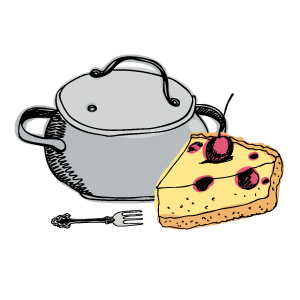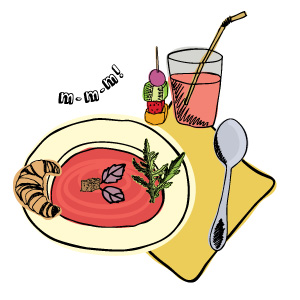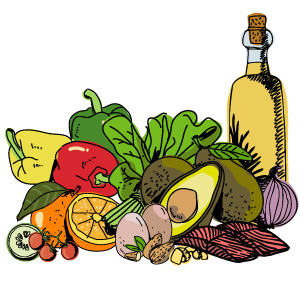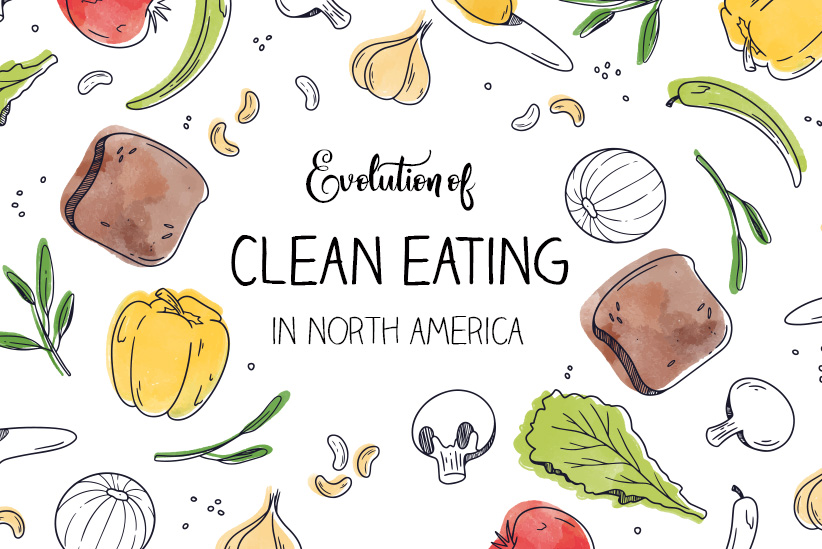From Natural, to Artisanal to Clean. We know that there are large group of specific customers that value uncomplicated simplicity when choosing to purchase foods. They demand transparency, and it seems that they just want their products to be honest. Straightforward eating choices very often bring about the theory of better health.
Our team at SNI have gradually witnessed this target audience grow to proportions bigger than we imagined—and we don’t predict that it will slow soon. These thoughts are not to be confused with current the clean eating diet fad, rather the consumer behavior theory surrounding the choices of avoiding refined foods and complicated ingredient lists. Is this all part of a temporary movement? Or has this demand always existed and re-emerged using new terms each time?
Where to begin
In an attempt to wrap our heads around the big picture, it’s probably best to look at a history of what consumers have wanted from their food over time—and why. TLDR? Jump to the conclusion, sometimes we all can be impatient.


Simpler times?
Maybe not easy-as-pie but cities and metropolitan areas are beginning to grow. So this is a big milestone for food manufacturing. As social status and class developed: it was considered that if you were able to eat a lot, this meant that you were fortunate and well-to-do.
At the same time, innovative doctors and chemists theorized that lack of nutrients can make you sick. This was also the age of inventing convenience: the first packed tuna, the first chocolate bar, processed cheese and the first Jell-O.
Mom seemed to make all the food purchasing decisions, and food manufacturers and marketers were eager to use technology to provide a longer shelf-life in foods. WWI sprouted a new awareness on appropriate nutrition for soldiers, and this led to the concept of fortifying foods and making them portable.

The war is over, stock market is up, and consumers have more money to spend. More than before, convenient nibbles stole the limelight. Food innovation created some of it’s most helpful technologies. Prepackaged meats, potato-peeling machines, flash-freezing pre-cooked foods, commercial baby foods, biscuit mixes—and of course—pre-sliced bread. The crash of the stock market in 1929 and the Great Depression that followed effected mom’s food budget and foods needed to last longer than before. Inexpensive one-pot meals from scratch were stretched to fill her families bellies.
A significant vestige in food marketing also began: the first home television was introduced—which also framed the basis of marketing foods through television commercials, providing some of our much-loved household excitement and expanded consumer demand for competition in the food industry. One has to wonder if the onset of meal and snack marketing created the spark of general skepticism around science and food, or if future generations look back at this era as the turning-point in what drives them to choose cleaner food options.


World War II forged more consumer habits and food innovation—especially to feed the troops. New food technologies like dehydrated potatoes, canned meat and converted rice became staples and their shelf-stability made them a popular choice.
During WWII metal cans were scarce, so the food consumer was introduced to frozen foods instead: fries, meat pies, pizza and full frozen entrees. Following this war, consumers no longer needed to ration their menus, consumption of grub soared.
Packaging of food and beverages was changed forever with the invention of resealable food containers in this decade. As suburban homes and sprawls grow, so does home refrigerators and the supermarket concept and size. Mandating of nutrition standards in school lunch programs is introduced, and America is unveiled to even more endless possibilities of international cuisines which sprouted massive spice sales. The microwave oven was accidentally invented, and so was the remove-control.
This truly was the decade of the inventor, paired with luxury and ease as options for the average kitchen.


Construction of a national highway system brought about mass distribution of food products and fast food. Mom wasn’t thrilled to go back and cook in the kitchen either, so the first ‘fast food burger chain’ was created.
This was also an opportunity for food marketers to appeal to mom by selling her an escape from being trapped in the kitchen and more frozen finger foods are created, as well as boxed casserole helpers. To no surprise, this was also the age of the “T.V. Dinner”.

This was also an opportunity for food marketers to appeal to mom by selling her an escape from being trapped in the kitchen and more frozen finger foods are created, as well as boxed casserole helpers. To no surprise, this was also the age of the “T.V. Dinner”.
This age also spawned the discovery of alternative sweetener options—amazingly—not primarily due to health concerns, but due to sugar shortage. High-fructose corn syrup (HFCS) was also developed which eventually resulted in lower-costs for food producers.
Cooking culture became trendy around the 1970’s in homes that could afford it—mostly thanks to First Lady Jackie and Julia Child. Yet, the average household still embraced shorter preparation times and convenience. The result also created the snack food explosion in North America utilizing more HFCS and more accessible pre-packaged food enclosures like re-sealable bags and pull-tab can openers.

Hippie-culture put a dent in convenient food interest, when the children of the Vietnam war demanded food-from-scratch, unprocessed foods. Unrefined in nature, the freethinking mindset of the flower child is clearly associated with directness. So, it makes sense that this type of consumer would correlate wholesome food as the correct choice.
One has to ask: was this the original clean eating movement?

The home’s primary grocery-shopper was still mom, but she was becoming more liberated. Which is why the household slow-cooker was so celebrated in the 70’s. She could set-it and forget it.
Turning the spotlight to Berkeley, California, an even bigger revolution was inflamed by Chef Alice Waters. Many would argue that this is the beginning of the clean-eating transformation, as Ms. Waters reintroduced the concept of cooking with natural, and seasonal ingredients—and making many significant and still-important arguments for the benefits of this lifestyle we still hold true today. Contemporary education on benefits of fresh and simple foods also sparked the beginning of the natural/organic category around this time.
Even herbal teas and ‘natural’ baby foods began to appear and marketed for simplified health benefits. Despite this new civilization of food education, many consumers were beginning to gain more weight, and the band-aid solution dressed up as ‘lite’ household choices were a magical marketing solution.


The stock market plummeted in 1987, and marketers noticed that consumers requested comfort foods like meatloaf, mashed potatoes and pasta. Microwave popcorn was also invented for stay-at-home entertainment and couch potatoes were commonplace in the average home. Soft drink consumption paired well with this lifestyle, and sucrose versions were created and marketed towards the average stationary loafer. We could probably pin this time in history as the boom of “quick fix food choices” and marketing food nutrition claims like low-fat, low-salt, and low-cholesterol were far and wide. While fast-food companies were gaining competition, they also began educating the market and consumers with nutrition and ingredient information.
Following significant increase in health concerns of North Americans from becoming more overweight, the federal US government began to take some responsibility for the diets of the public. The USDA introduced its first Food Guide Pyramid in attempt to model consumption and diet planning. The early 1990’s was the first time the US congress approved a standard nutrition label that provided a measurable standard for nutrition claims that marketers were pounding consumers with. This was also a significant milestone in time in that the FDA dietary guidelines actually endorsed vegetarian lifestyle options. The notion of scaling back to straightforward eating was actually being encouraged by the government.

The new wave of functional foods and nutraceuticals helped consumers understand and begin to investigate optimum consumption habits. The average North American is desperately trying to lose weight and fell hard for new diet trends. Many believing that these fad diets gave them permission to indulge in guiltless binging in a painless way.
The workplace is changing, and mom is taking part in the workforce. Understandably, microwave ovens became the primary technology. Lots of packaging was designed with this in mind, springing the design for home meal replacement (HMR) as well as pre-cooked meals, partially cooked or ready-to-eat (RTE). This made it easier for mom to take home a fully-cooked meal on her way home from work for family dinner.

Desperate for a utopian future, the beginning of the new millennium felt like a new start. But politics forced North Americans to reconsider their inclination for isolation and safety. This fear caused the recirculation of demand for comfort foods again. Obesity is becoming increasingly taxing on medical costs and consumers are aware of it. In an attempt for a new solution again: low-carb diets erupted on retail shelves and within consumer cabinets. It was a brief spike in progression, but low-carb solutions lost their dazzle after a few years. Are we seeing this re-emerge disguised as other fad diets today?
In response to cholesterol concerns, plant sterols were proposed as prevention, as well as reduced fat options to consumer favourites. Determined to still be able to sell consumers on the idea to enjoy some luxury, marketers also rolled-out portion-controlled snacks. Heart health messages are pushed into advertising, and a more individualized approach to improving diet and lifestyle was debuted with a new interactive Food Guide Pyramid.

We could philosophise in multiple facets about which initial historical event is the causation for the current appeal for what we refer to as “clean eating”. Fundamentally it drives sales from the perspective of demand: choosing an option that portrays purity, truth and naturalness. Today we see more consumers associating their choices based on “trust” with manufacturers of food. Is it achieved by developing a product use as little ingredients as possible? Easy-to-recognize ingredients? Did it stem from society’s initial skepticism around science and food? Or did a clean eating trend come to light from the initial mandating of nutrition standards in school lunch programs? Perhaps the 1960’s hippies were the true founders of ‘simple’ and ‘clean’ eating. Many industry professionals would pin the official movement in thanks to activist and chef Alice Waters.
Based on this brief journey through time—I think it’s safe to say consumers have always wanted to improve, speculate and question their food and how it contributes to their health, and the market and industry was happy to help facilitate more exploration, education and innovation.
Ultimately, there is not anything “wrong” with seeking out clean foods. But can be worth observing that that all ingredients in our food have been extensively studied and deemed safe by the appropriate regulating bodies. Most of the concern by consumers surrounding things like artificial flavours or hard-to-pronounce names is merely a symptom of many consumers’ lack of familiarity with science, and lack of familiarity reacts with mistrust. Which is also why our team at SNI continues to strive to learn more on what makes your consumers choose your products.




